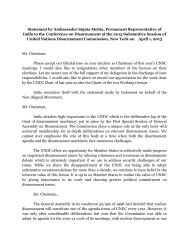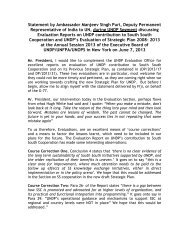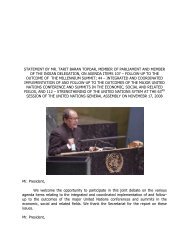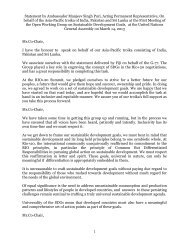STATE OF THE WORLD'S CITIES 2012/2013 Prosperity
STATE OF THE WORLD'S CITIES 2012/2013 Prosperity
STATE OF THE WORLD'S CITIES 2012/2013 Prosperity
Create successful ePaper yourself
Turn your PDF publications into a flip-book with our unique Google optimized e-Paper software.
It is possible to identify the specific contributions adequate<br />
infrastructure can make to the prosperity of cities, but it must be<br />
remembered that they are interrelated and interact with one another<br />
in a variety of ways. As perceived by experts participating in the<br />
UN-Habitat survey, these contributions are the following (by order<br />
of decreasing importance): economic growth; facilitating mobility;<br />
improving access to health and education; improving quality of life;<br />
steering spatial expansion; environmental quality; improving slum<br />
conditions and reducing poverty; and reducing spatial disparities.<br />
These eight types of contribution are presented in the charts for the<br />
four regions under review.<br />
Economic Growth: Infrastructure plays a crucial role in supporting<br />
economic growth, and it is worth noting that the reverse causal<br />
relationship also holds – that is, infrastructure benefits from<br />
economic growth. Infrastructure contributes to growth through<br />
enhanced productivity of the factors of production. Indeed between<br />
1990 and 2005, improved infrastructure contributed one per cent<br />
to per capita economic growth in Africa, and 1.2 per cent in<br />
Asia. 48 In Africa, the greatest impact has been attributed to<br />
telecommunications and, to a lesser extent, roads.<br />
Facilitating Mobility: Seamless movement within and between<br />
cities thanks to efficient mass transit systems is essential to the<br />
proper functionality and prosperity of cities. Cities that have deployed<br />
sustainable transport policies to enhance mobility have reaped huge<br />
advantages that positively impact on the other ‘spokes’ of prosperity.<br />
In Bogotá and Curitiba, for instance, BRT makes both cities more<br />
livable in very tangible ways, including reducing traffic congestion,<br />
decreasing travel times and costs, reducing energy consumption and<br />
improving environmental quality.<br />
Access to health and education: Infrastructure facilitates access<br />
to health and education, which are essential components of<br />
human development and feature prominently among Millennium<br />
Development Goals. Healthy children learn better and healthy<br />
adults work better – both being major assets to the city. Education<br />
is crucial to empowerment, reducing poverty and enhancing<br />
productivity. Cities with a healthier, better-educated workforce are<br />
more likely to be productive and competitive.<br />
Improving quality of life: Infrastructure can improve quality of<br />
life in a variety of ways, including: enhancing safety and security,<br />
especially for youth and women; and expanding the provision of<br />
public goods to enhance the city’s appeal.<br />
57<br />
POLICy<br />
Urban Infrastructure: Bedrock of <strong>Prosperity</strong><br />
The provision of infrastructure must take into<br />
consideration the needs of women.<br />
Steering spatial expansion: Infrastructure can steer the spatial<br />
expansion of a city, facilitating more compact urban development<br />
and integrating different land uses. This urban form is deemed<br />
to be efficient, inclusive and sustainable in four different ways:<br />
(1) the costs of infrastructure are cheaper; (2) access to services<br />
and facilities is improved; (3) the livelihoods of the urban poor are<br />
enhanced; and (4) social segregation is reduced.<br />
Environmental quality: Many developing country cities are<br />
characterized by inadequate water supply and squalid conditions in<br />
terms of sanitation. These two components of infrastructure are vital<br />
to improved environmental conditions in cities, as they facilitate a<br />
clean and pollution-free environment. On top of this, flood-control<br />
infrastructure safeguards urban areas against erosion, flooding,<br />
landslides and disasters.<br />
Improving slum conditions and reducing poverty: Infrastructure<br />
can contribute to the prosperity of cities through improved slum<br />
conditions and reducing poverty. Providing adequate infrastructure<br />
for roads, water, sanitation and electricity can reduce the health<br />
burden faced by slum dwellers, delivering major benefits in terms of<br />
environmental quality.<br />
Reducing spatial disparities: Infrastructure can reduce spatial<br />
disparities, particularly in uncontrolled and un-serviced peri-urban<br />
areas, connecting them to consolidated parts of the city.<br />
POLICy<br />
Beneficiary communities must be fully<br />
involved in the design, provision and<br />
maintenance of infrastructure.















![1 statement by dr.[mrs] kakoli ghosh dastidar - Member States Portal](https://img.yumpu.com/27526598/1/190x245/1-statement-by-drmrs-kakoli-ghosh-dastidar-member-states-portal.jpg?quality=85)

